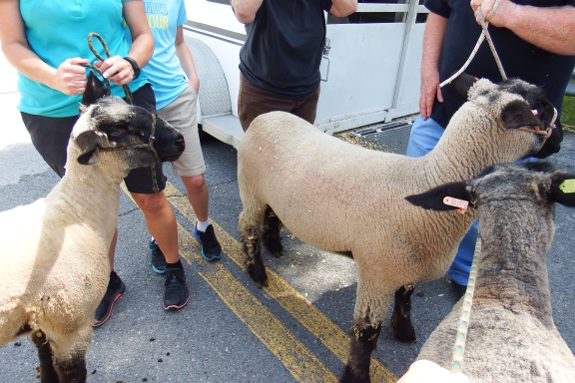
Workarounds for dewormer resistance in sheep and goats

As I learned the hard
way, you can use all kinds of holistic methods to keep sheep and goats
healthy but at some point you'll end up having to rely on
pharmaceuticals. Although it wasn't our issue last year, the most
common problem requiring that step in our region is internal parasites
--- worms.
The trouble is,
dewormers have been used with such wild abandon in the U.S. that many
don't work any longer. The worst offender --- barberpole worm --- was
found to be resistant to three of the four classes of dewormer in every
farm studied last year in Virginia and Georgia. Only the nicotinic
agents (Levamisole) were still effective in that study, and even that
class only worked in 30% of Georgia farms and 50% of Virginia farms.
The benzimidazoles (such as Safeguard) and the macrocyclic lactones
(such as Ivomec and Cydectin) are now useful only for lesser parasites
such as tapeworms.
Luckily, there are a few
methods available to make supposedly ineffective drugs more effective.
First of all --- don't use them! The
alternatives mentioned last year are still a good first step, along
with pasture rotation. And, of course, you should use a FAMACHA
test so you'll only treat individuals that have a high worm load.

But what if you have a
sheep or goat that is dangerously anemic due to barberpole worms...and
your farm is showing resistance to all of the available drugs? First of
all, make sure you're dosing properly. Even though it doesn't say so on
the bottle, goats have a higher metabolism than sheep and should be
given twice as high a dose on a body-weight basis as sheep should (or
1.5 times as much for Levamisol). Using less just speeds up dewormer
resistance on your farm.
Second, you can prolong
the efficacy of certain drugs even if there's already some resistance
to the drug on your farm in a few different ways. Keeping your animal
off feed for twenty-four hours before dosing will make the drug more
effective since food dilutes the dewormer. Second, you can give a full
dose of Safeguard then repeat in twelve hours, which was shown in one
study to increase the kill rate of the dewormer from 50% to 92%. (With
Levamisol, you'll want to wait 24 hours before repeating, while
repeating didn't prove effective for the other classes.)
Finally, you can double
up different classes of drugs to kill off a lot more worms. For
example, if parasites on your farm are resistant enough to three
different drugs so each one only kills 60% of the worms, dosing with
all three drugs at once will eliminate over 90% of the problem ---
pretty good for dewormers that you probably considered useless on your
farm!
I hope the worms never
get bad enough on our farm that I have to use this information...but
I'm posting anyway in case either I (or you) do go there. Good
luck...and please never deworm willy-nilly without testing each animal
first to see if he or she needs it.
(Information courtesy of
Dr. Dahlia O'Brien, Small Ruminant Specialist for the Virginia
Extension Service...and really good speaker. If you get a chance to
attend one of her workshops, I highly recommend it!)
Want more in-depth information? Browse through our books.
Or explore more posts by date or by subject.
About us: Anna Hess and Mark Hamilton spent over a decade living self-sufficiently in the mountains of Virginia before moving north to start over from scratch in the foothills of Ohio. They've experimented with permaculture, no-till gardening, trailersteading, home-based microbusinesses and much more, writing about their adventures in both blogs and books.
Want to be notified when new comments are posted on this page? Click on the RSS button after you add a comment to subscribe to the comment feed, or simply check the box beside "email replies to me" while writing your comment.

Did they say anything about the usage of copper?
I was amazed that goats aren't harmed by having copper boluses in their innards.
While humans can process and need copper in the form of organic compounds, metallic copper is a heavy metal and actually toxic to humans when ingested. Or when some kinds of food are cooked in copper cookware. (In both cases you need long-term expoure to do harm; touching a brass doorhandle or drinking water transported by copper tubing won't produce enough exposure.)
Good question since I share your concerns! That said, their studies have been very much in favor of copper, which has been shown to be 80% or more effective. They do warn against using copper sulfate, which is more bioavailable than the COWP they recommend (and which we use).
I specifically asked them this time around what kind of signs to watch for to see if your animals are getting too much copper. They said the first sign is a very red, coppery urine that looks almost like blood.
What I didn't ask because I suspect the studies are too hard to be worthwhile in animals is --- are there milder negative repercussions that might not have been picked up by their study? How does copper affect the animals' guts long term, and does it impact the intestinal flora?
My minor misgivings aside, it is true that goats have very high copper needs that usually aren't met nutritionally in our climate. And studies so far have supported giving COWP to goats.
At a guess I'd say that it would be hard for the intestinal flora not to be affected, since copper is such an effective biocide.
OTOH, if a copper bolus would kill a significant fraction of gut bacteria, I would think that you'd notice that in fodder coming out practically undigested.